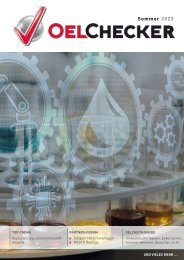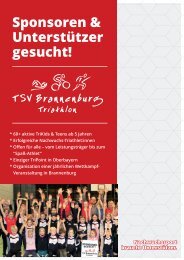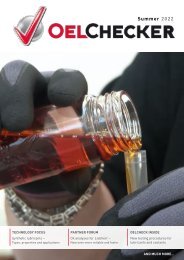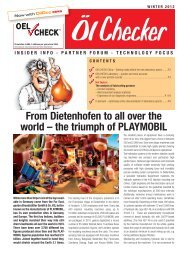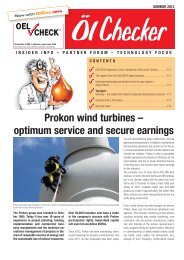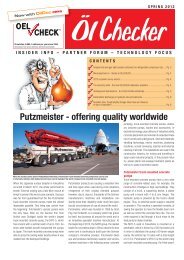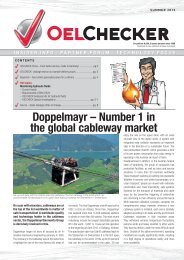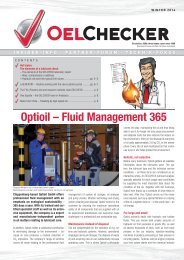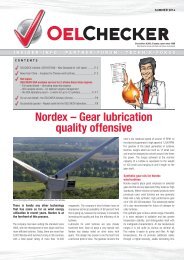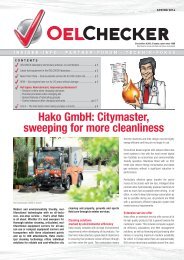OELCHECKER - Spring 2013
> Editorial – OELCHECK takes decisive steps for the years to come > OELCHECK – A strong brand with a new look > New services offered by the OELCHECK laboratory > Lubricants and condition monitoring – OELCHECK recognises trends > Gas engine oils – Latest information on oxidation determination > China – Opening of the OELCHECK laboratory in Guangzhou > Q & A – How can there be high levels of wear metals with normal purity classes? > OilDoc news
> Editorial – OELCHECK takes decisive steps for the years to come
> OELCHECK – A strong brand with a new look
> New services offered by the OELCHECK laboratory
> Lubricants and condition monitoring – OELCHECK recognises trends
> Gas engine oils – Latest information on oxidation determination
> China – Opening of the OELCHECK laboratory in Guangzhou
> Q & A – How can there be high levels of wear metals with normal purity classes?
> OilDoc news
- No tags were found...
You also want an ePaper? Increase the reach of your titles
YUMPU automatically turns print PDFs into web optimized ePapers that Google loves.
SPRING <strong>2013</strong><br />
Circulation: 9,000; 3 issues per year since 1998<br />
Download at www.oelcheck.de/news downloads<br />
CONTENTS<br />
Editorial – OELCHECK takes decisive steps for the years to come ............. p. 2<br />
OELCHECK – A strong brand with a new look .......................................... p. 3<br />
New services offered by the OELCHECK laboratory .................................. p. 3<br />
Bayernoil – Gas and steam turbines generate power ................................ p. 4<br />
Gas engine oils – Latest information on oxidation determination ................ p. 5<br />
China – Opening of the OELCHECK laboratory in Guangzhou ................... p. 6<br />
Q & A – How can there be high levels of wear metals with<br />
normal purity classes? ............................................................................ p. 8<br />
Wirtgen Group – Technology leader in<br />
the construction machinery industry<br />
deposits and technologies for processing of raw<br />
minerals and recycled materials.<br />
The Wirtgen Group of companies are globally active<br />
in the construction machinery industry, with four<br />
long-standing brands.<br />
Four strong brands; over 90 innovative<br />
products on display, of which 29 trendsetting<br />
world premiers; 10,560 m² of<br />
exhibition space; and more than 100 experts<br />
with application experience – these<br />
impressive figures characterise the presence<br />
of the Wirtgen Group at Bauma <strong>2013</strong><br />
and clearly demonstrate the innovative<br />
strength of this company in the Road and<br />
Mineral Technologies sector.<br />
Road Technologies includes technologies for road<br />
construction and maintenance. Mineral Technologies<br />
includes extraction technologies for mineral<br />
• Wirtgen provides innovative solutions for road<br />
construction and material extraction, and for<br />
over 50 years it has been pioneering better<br />
performance on the job site for its customers<br />
everywhere in the world.<br />
• Vögele has more than 80 years of experience in<br />
developing and producing road finishing machines<br />
and is today the leading manufacturer worldwide.<br />
• Hamm offers a wide range of products for all segments<br />
of the earth-moving and road construction<br />
industry and stands for advanced machine and<br />
compaction technology.<br />
• Kleemann specialises in the erection of mobile<br />
crushing and screening plants.<br />
The sophisticated parent plants of the four mechanical<br />
engineering specialists are all located in Germany.<br />
All of the plants have specialised expertise accumulated<br />
over many decades. The entire production<br />
process in each plant, from machine development<br />
to assembly and quality assurance, is specifically<br />
aligned to the corresponding product portfolio of the<br />
associated brand.
Each month we welcome over 100 companies as new customers<br />
thanks to word-of-mouth advertising. We presently<br />
have more than 15,000 satisfied customers. Thanks to the<br />
opening of our new laboratory in China, their numbers will soon<br />
grow even more. Ever since our company was established in 1991,<br />
we have planned its successful development consistently and with<br />
a focus on the future. After more than 20 years, we consider it<br />
necessary to take some decisive and trend-setting steps for the<br />
years to come, which go far beyond revamping our corporate<br />
design.<br />
For many years already, our founders Barbara and Peter<br />
Weismann, both of whom are still actively involved in the company, have been grooming the<br />
members of the next generation for their management roles in the family-run businesses OELCHECK<br />
and OilDoc Academy.<br />
Their son Paul Weismann, who studied chemistry in the U.S., joined the management ranks of<br />
OELCHECK in 2002. He is also responsible for managing the laboratory in China.<br />
Their daughter Petra Bots has been handling the marketing and websites of both companies since<br />
1998. Along with our seminar facilitator Rüdiger Krethe, she is now active in the management of the<br />
OilDoc Academy. She took over this role from Peter Weismann on the 1st of April, when Peter moved<br />
on to the Advisory Board.<br />
Their son-in-law Steffen Bots, an industrial engineer who has been responsible for diagnosing<br />
analysis results at OELCHECK since 2004 and has headed the diagnostic team since 2010, will set<br />
up a sales and marketing department and put his practical experience to use in direct contact with<br />
our customers and prospective customers.<br />
This creates a unique opportunity for an experienced mechanical engineer to assume the role of<br />
head of the diagnostic team at OELCHECK. You can find our corresponding job advert on page 8<br />
of this issue, with detailed information available at www.oelcheck.de.<br />
Yours, Barbara Weismann<br />
The overseas production sites of the Wirtgen<br />
Group, located in Brazil, China and India, meet the<br />
same high standards for machine quality and<br />
production efficiency.<br />
A single workshop for all<br />
brands of the Wirtgen Group<br />
For the customers, taking ownership<br />
of a machine marks the start<br />
of a long-term service relationship.<br />
The team of experts in the Wirtgen<br />
Group customer service department<br />
are always available to answer any<br />
questions about the machines and<br />
their operation. The service specialists<br />
at the subsidiaries and distributors<br />
of the worldwide Wirtgen<br />
Group, as well as the teams in the<br />
parent plants of Wirtgen, Vögele,<br />
Hamm and Kleemann, ensure short<br />
response times and quick solutions.<br />
Thanks to well-trained technicians and modern<br />
shop equipment, the subsidiaries are able to<br />
provide the full spectrum of reliable shop service.<br />
The range of services includes inspection, servicing<br />
and overhauling of machines, as well as repairs and<br />
corrective maintenance.<br />
In order to be able to meet all the service requirements,<br />
the shops are furnished with special equipment<br />
adapted to the machines made by Wirtgen,<br />
Vögele, Hamm and Kleemann. Downtimes are minimised<br />
by the continual modernisation of the shops,<br />
high availability of all spare parts and wearing parts,<br />
sophisticated special tools, diagnostic software for<br />
fault analysis and optimised workflows. In addition,<br />
service centres close to customers, well-equipped<br />
service vehicles and the extensive expertise of the<br />
service technicians and specialists in the parent<br />
plants reduce machine downtime on the job site.<br />
An OELCHECK universal<br />
five-sample kit<br />
Every job site is different<br />
and poses different<br />
challenges to people<br />
and machines.<br />
The machines<br />
made by Wirtgen<br />
Group never work under standard<br />
conditions, so they need lubricants and<br />
filters perfectly matched to actual conditions.<br />
Only lubricants that have been extensively tested<br />
by the Wirtgen Group are used for initial filling at<br />
the plant. Naturally, these engine, gearbox and<br />
hydraulic fluids, as well as the selected greases,<br />
are available for oil changes and relubrication.<br />
From the customer perspective, the lubricants that<br />
are used must ensure:<br />
• reliable compatibility with the initial filling;<br />
• optimal wear protection;<br />
• perfect corrosion prevention;<br />
• traceability in case of damage;<br />
• extended change interval after oil analysis.<br />
For many years the company has been relying<br />
on OELCHECK service for lubricant analysis.<br />
A special analysis kit has now been developed for<br />
the Wirtgen Group. The silver-grey box holds five<br />
sample containers with grey lids, sample sheets<br />
and shipping pouches. What makes it special is<br />
that every kit can be used not only for assessing<br />
oil from diesel engines, gear units or hydraulic systems,<br />
but also for diesel fuel as necessary. With<br />
the practical „OELCHECK / FUELCHECK box“, the<br />
operators and service staff always have the right<br />
tool at hand, regardless of whether the objective of<br />
the analysis is to determine the reusability of an oil,<br />
signs of damage, contamination, or the quality of<br />
a lubricant or diesel fuel.<br />
„Close to our customers“ is the value proposition<br />
of Wirtgen Group to its customers. The new<br />
OELCHECK universal five-sample kit is the latest<br />
example of how this promise is fulfilled.<br />
For more information:<br />
www.wirtgen-group.com<br />
2
OELCHECK INSIDER INFO<br />
OELCHECK – A strong brand with a new look<br />
After more than 20 years, it was time to give a fresh look to the OELCHECK logo and all<br />
other design elements. After all, our brand presence should clearly communicate the<br />
services and values of our company.<br />
From now on, our brand presence will be much more eye-catching and dynamic than before. With its clear<br />
shapes, attractive colours and lucid layout, the OELCHECK design is unmistakable.<br />
Even the popular „Oil Doctor“, with his aura of experience, now looks as young and active as he is in reality.<br />
You can get acquainted with him on the front page of this issue of <strong>OELCHECKER</strong>.<br />
Meet us at Bauma:<br />
Hall A4, Stand 531<br />
He is making his grand appearance Bauma stand in Munich.<br />
We cordially invite you to visit us at Stand 531 in Hall A4.<br />
Transformer oil furan determination indicates the condition of the insulating paper<br />
Lab Manager Jan Hubrig starts a furan determination.<br />
Direct contact between the copper wires of<br />
a transformer, which would lead to failure, is<br />
prevented by insulating paper.<br />
In order to assess the remaining<br />
service life of the transformer,<br />
a paper sample can be removed<br />
and analysed after the transformer<br />
is opened up. Furan<br />
determination of the used transformer<br />
oil now provides a much<br />
simpler and cheaper alternative.<br />
Cellulose degradation in the<br />
insulating oil gives rise to oilsoluble<br />
decomposition products,<br />
in part due to high temperatures,<br />
and they can be determined<br />
using chromatography. Since<br />
these substances cannot be converted<br />
to the gaseous phase without decomposition,<br />
a gas chromatograph, as used for gas-in-oil analy-<br />
sis, is not suitable for determining paper ageing. For<br />
this reason, we have installed a new HPLC unit in<br />
the OELCHECK laboratory. The Perkin Elmer Flexar<br />
Pump uses the high performance liquid chromatography<br />
(HPLC) method. Using the DIN 61198<br />
procedure, it determines furan derivatives dissolved<br />
in oil, which can originate from the insulting paper,<br />
in 10-ml oil samples. It distinguishes between<br />
5-hydroxymethyl-2-furfural (5HMF), 2-furfuryl<br />
alcohol (2FOL), 2-furfural (2FAL), 2-acetylfuran<br />
(2ACF) and 5-methyl-2-furfural (5MEF).<br />
Based on the concentrations of the individual<br />
derivatives in mg/kg (ppm), conclusions can be<br />
drawn about the condition of the insulating paper.<br />
Internal inspection of the transformer is only<br />
carried out if elevated furan values signal the<br />
need for action. Furan determination is now<br />
available as a special test.<br />
Low particle quantification (PQ)<br />
index values are now shown as<br />
numerical data<br />
We show the PQ index for every oil and grease sample under „Wear“ in each<br />
laboratory report. We have always indicated values below 25 as „OK“ because<br />
precise measurement is not possible below this level. Since an increasing<br />
number of customers are asking what numerical value stands behind this „OK“,<br />
from now on we will show „PQ < 25“ if the measured PQ index is below 25.<br />
The PQ index provides information about magnetisable iron wear particles in<br />
the entire sample. When compared with the stated iron content in mg/kg, it<br />
enhances the diagnosis of the possible source of the iron and the origin mechanism.<br />
While the amount of iron measured with the ICP only relates to particles<br />
smaller than 3 μm, the PQ index provides information about all magnetic iron<br />
particles that are present, regardless of size.<br />
Deposits in turbines and<br />
oil circulation systems<br />
The MPC test is now an ASTM standard<br />
Membrane patch colorimetry (MPC) is a proven test method for<br />
the detection and quantitative assessment of insoluble oil residues.<br />
Especially in turbines and large circulation systems, oil fillings of<br />
several thousand litres are often used for several years. Thanks to<br />
careful monitoring with the MPC test, sticky reaction products or sludge-forming<br />
and soft contaminants do not go undetected.<br />
OLCHECK has been offering the MPC test since 2010 as an additional special<br />
test. The American Society for Testing and Materials (ASTM) has now specified<br />
the MPC test in the ASTM D-7843 standard. OELCHECK also had a part in this,<br />
since we actively supported an extensive pooled test over many months.<br />
3
OELCHECK PARTNER FORUM<br />
Lubricants and Condition Monitoring –<br />
OELCHECK Recognises Future Trends<br />
Lubricant analysis plays a vital role in the monitoring of machinery, or condition monitoring. It provides a wide range of physical<br />
and chemical characteristics that can be used to deduce the condition of both the lubricant and the components of the machine<br />
alike. However, lubricant analysis is set to become even more significant in the future as the demands placed on lubricants<br />
continue to increase. With regard to lubrication and its impact on production and maintenance, OELCHECK diagnostics<br />
engineers are confronted with trends that are bound to become increasingly important in the coming years.<br />
4<br />
Trend 1: Long-Term and Lifetime<br />
Lubrication<br />
Oil is not a renewable resource, and the aim is now<br />
clearly to achieve substantially longer lubricant service<br />
life. Depending on the application concerned,<br />
the often advocated concept of lifetime lubrication<br />
is a potential option. But independent of this, the<br />
trend with regard to long-term use is primarily moving<br />
towards higher-quality base oils (group II or III).<br />
Formulated with highly effective oxidation inhibitors,<br />
these allow you to achieve even longer service<br />
life. Even today, use intervals of 10 years can be<br />
achieved with high-performance industrial gear oils.<br />
In the automotive sector, the aim is to eliminate the<br />
periodic changing of automatic transmission fluids.<br />
Trend 2: Designed to Application<br />
Simplification of the types of lubricants used must<br />
be on the wish list of almost every maintenance<br />
technician. However, the OELCHECK diagnostics<br />
engineers are often confronted with a countertrend.<br />
It is called „designed to application“ and<br />
means that lubricants are tailored to specific applications.<br />
This is the case, for example, for roughly<br />
85% of all automotive lubricants. Around 20 years<br />
ago, the proportion was only 25%.<br />
Another example is industrial gear oils for modern<br />
high-tech gears. In the past, two types of base<br />
oil and four types of active ingredient were available<br />
for the formulation of lubricants. Nowadays,<br />
due to ever-increasing technical demands there<br />
are four different base oils and up to 23 additive<br />
combinations. These tailored products represent a<br />
major challenge for lubricant producers. They also<br />
increase the need for us as analysts, as the wide<br />
range of possible combinations and substances<br />
makes it increasingly difficult to assess the exact<br />
service times of used oils.<br />
Trend 3: Higher Energy Efficiency<br />
Lubricants have an immediate effect not only<br />
on engines and machine components, including<br />
their wear and service life, but also on energy<br />
efficiency. Low-viscosity, low-friction motor oils<br />
have been reducing fuel consumption for many<br />
years. Motor<br />
oil developers will<br />
exploit this potential to a<br />
substantially higher degree<br />
in the future. More and more, the<br />
behaviour of industrial lubricants is being<br />
critically analysed with regard to the efficiency<br />
and performance of the machines.<br />
For many suppliers of modern oils and greases,<br />
energy conservation is a key selling point because<br />
hydraulic fluids or gear oils formulated with specific<br />
additives can save thousands of euros in energy<br />
costs.<br />
Trend 4: Increasing Demands on<br />
Environmental Impact<br />
This primarily relates to hydraulic fluids for mobile<br />
hydraulic systems. However, it also affects total loss<br />
lubricants such as lubricating greases, adhesive<br />
oils or two-stroke mixtures. They must also meet a<br />
multitude of requirements. Biohydraulic fluids need<br />
to remain in use for as long as possible in order to<br />
drive down oil and maintenance costs. At the same<br />
time, they are expected to provide an optimum level<br />
of operational reliability. However, specific environmental<br />
requirements need to be taken into account<br />
when formulating biolubricants. And when it comes<br />
to using plant oils as more readily biodegradable<br />
base oils, understanding how extreme pressure<br />
(EP) additives work is a science in itself.<br />
Trend 5: Lubricants that are Essential to<br />
Facilitate Technical Applications<br />
Alternative construction materials, engines with<br />
catalytic converters or diesel particulate filters, and<br />
modern machining methods are just a few of the<br />
many technological developments that are only<br />
possible with specifically formulated lubricants or<br />
cutting fluids.<br />
For instance, ceramics respond to additives in a<br />
completely different way than metals. Conventional<br />
oils and greases are only suitable to a certain<br />
extent for the lubrication of ceramic components<br />
used in piston rings, roller bearings, compressors,<br />
high-temperature gas turbines or other equipment.<br />
Modern materials can be produced more precisely<br />
and can therefore be more resistant to temperature<br />
and wear than metals. However, their precise surfaces<br />
with low roughness require lubricants that are<br />
„thinner“ and therefore more energy efficient.<br />
In machine tools, metals are predominantly<br />
machined using emulsions of water-miscible cooling<br />
lubricants. A trend towards dry machining is<br />
becoming increasingly clear here. This involves<br />
replacing the emulsion by a very small quantity of<br />
a fully synthetic high-additive oil that is dispensed<br />
directly and precisely through the tool to the cutting<br />
surface. In the case of engines, catalytic converters<br />
and particulate filters make it possible to comply<br />
with evermore stringent emissions standards. However,<br />
for best results and trouble-free operation<br />
these components require low-SAPS motor oils.<br />
These oils contain a lower proportion of sulphur<br />
and phosphorous additives, which are considered<br />
catalyst poisons, and therefore generate fewer<br />
deposits. Low-viscosity motor oils that have been<br />
developed with energy efficiency and environmental<br />
impact in mind are set to play an increasingly<br />
significant role in the future as formulas must<br />
be adapted to comply with the further tightening of<br />
emissions standards.<br />
Trend 6: More Effective Monitoring and<br />
Maintenance of Lubricants<br />
An essential factor for longer operating life is even<br />
more careful maintenance and monitoring of lubricants.<br />
Contamination of oils and greases by wear<br />
particles and other contaminants also increases<br />
over time. Monitoring and maintenance measures<br />
are mandatory because the machines and equipment,<br />
and in turn production reliability, are ultimately<br />
dependent on these measures. Accordingly,<br />
increasingly fine full-flow and partial-flow filters are<br />
being used, and analysis both onsite and in the lab<br />
is becoming indispensable.
OELCHECK TECHNOLOGY FOCUS<br />
Oxidation of gas engine oils<br />
Why does infrared spectroscopy sometimes come up short?<br />
In assessing how much longer a gas engine oil can be used or whether an oil change is necessary, oil ageing or oil oxidation is a<br />
crucial factor. Long periods of oil use, relatively high operating temperatures or rising contamination levels aggravate oil oxidation<br />
and the associated formation of acidic reaction products. Oils in gas engines fuelled with biogas, landfill gas, sewage gas or wood<br />
gas are often exposed to acidic gas components. Since the composition of these gases often varies, changing the oil at fixed intervals<br />
can be risky, in contrast to the situation with relatively clean natural gas. Oils in biogas engines must therefore be monitored<br />
constantly using lubricant analysis according to manufacturer specifications.<br />
[%]<br />
smission [<br />
Trans<br />
19 A/cm<br />
1<br />
<br />
F<br />
Differ<br />
smission [%]<br />
Tran<br />
1 A/cm<br />
Used oil<br />
Fresh oil<br />
Differential spectrum<br />
1960<br />
1760<br />
1560<br />
1360 1160 960<br />
[cm 1 ]<br />
760<br />
560<br />
1960<br />
1760<br />
1560<br />
1360 1160 960<br />
We [cm -1 ]<br />
760<br />
560<br />
Valid oxidation determination according to DIN 51453 (left) and similar oxidation determination spoiled by ester components (right).<br />
A DIN standard<br />
that is no longer effective<br />
For a long time infrared spectroscopy was the<br />
only method for measuring oil oxidation. With the<br />
mineral oils predominantly used around 20 years<br />
ago, the spectrum indicated the oxidation so clearly<br />
that values determined using the IR method according<br />
to DIN 51453 were specified by gas engine<br />
manufacturers. This was based on the fact that<br />
ageing is accompanied by the accumulation of<br />
oxygen on the molecular chains of the hydrocarbon<br />
oils and the formation of new molecular chains.<br />
When they are illuminated with infrared light, they<br />
absorb it differently than fresh oil. A clear peak is<br />
visible in the IR spectrum of an oxidised mineral oil<br />
at a wave number of about 1,710 cm -1 . After the<br />
fresh oil spectrum is subtracted from the used oil<br />
spectrum in this region, the oxidation is stated as<br />
the IR absorption referenced to a one-centimetre oil<br />
layer thickness (A/cm).<br />
However, this logical procedure does not work with<br />
some modern gas engine oils. In region of wave<br />
number 1,710 cm -1 , the IR spectrum also indicates<br />
the double bonds typical of synthetic oils containing<br />
esters or some oil additives. Oxidation products<br />
and esters cause peaks in the same region,<br />
with a distinct overlapping of the ester peaks and<br />
the oxidation peak.<br />
For gas engine oils based on petroleum, IR spectroscopy<br />
still provides reliable information on oil<br />
ageing and the limits specified by the DIN standard<br />
are still valid. But since many modern gas engine<br />
oils contain synthetic group I or group II base oils<br />
and most of them also contain low-ash additives, IR<br />
spectroscopy in accordance with the DIN standard<br />
cannot provide any useful oil oxidation values for<br />
these oils. Base oils and additives may contain thermally<br />
stable ester-based synthetic oils that distinctly<br />
overlap the oxidation peak at the specified wave<br />
number of 1,710 cm -1 . If such a peak is already<br />
present in the fresh oil, subtraction often does not<br />
provide a meaningful oxidation value. Even heavily<br />
oxidised oils will yield a value of 1 A/cm. The value<br />
at 1,710 cm -1 often lies on a shoulder of the peak,<br />
giving rise to what appears to be strongly varying<br />
oxidation values. For example, a value of 1 A/ cm,<br />
18 A/ cm or even 27 A/ cm might be calculated for<br />
oils with the same degree of oxidation using the<br />
standard-compliant method.<br />
High time for a new, uniform rule<br />
Engine manufacturers and insurance companies<br />
are still specifying that the oxidation value has to be<br />
determined using IR spectroscopy in accordance<br />
with DIN 51453, and most of them set a limit of<br />
20 A/cm. This is counter-productive for assessing<br />
some modern oils. It is high time to define a<br />
standard test method for determining oxidation that<br />
is also valid for modern gas engine oils. It should be<br />
defined such that it can be implemented worldwide<br />
in any laboratory for used oil analysis.<br />
Until then, we at OELCHECK wish to assure our<br />
customers that when assessing the ageing of<br />
modern engine oils we do not rely solely on oxidation<br />
as determined in accordance with DIN 51453,<br />
which is not usable in this situation. Instead, we<br />
presently use trend analysis of a combination of<br />
several analysis values as a reliable way to evaluate<br />
ageing. Along with the engine type, the gas type<br />
and the engine oil used, the findings from IR spectroscopy<br />
are augmented by viscosity, AN, BN, and<br />
ipH data. In making this assessment, OELCHECK<br />
diagnostic engineers benefit from their extensive<br />
experience and our comprehensive database. Our<br />
customers can therefore rely on accurate oil ageing<br />
information in the laboratory reports. However,<br />
a standardised redefinition of the test method is<br />
urgently needed.<br />
P.S.: The situation with modern gas engine oils<br />
is not the only one where determining oxidation<br />
by subtracting peaks at a specific wave number<br />
causes problems. New synthetic gear oils, such as<br />
those used in wind turbine gear units, present a<br />
similar problem in oxidation determination because<br />
many of them also contain synthetic base oils or<br />
ester-based additives.<br />
5
OELCHECK CHINA<br />
Guangzhou (Canton), southern China, 22/03/<strong>2013</strong><br />
– At exactly 10 a.m., the doors of OELCHECK China<br />
Ltd. swung open in the first of the two 38-storey<br />
office towers of the Tian An Hi-Tech Ecological<br />
Park. The first of more than 150 guests had already<br />
arrived to join us in celebrating the official opening<br />
of the new OELCHECK laboratory in China. After<br />
being welcomed by the entire management team<br />
of OELCHECK, the guests could hardly contain<br />
their astonishment. The laboratory and associated<br />
offices occupy an impressive 550 square metres on<br />
the third floor of the tower. In the past few months,<br />
the premises had been fitted out with water and<br />
electricity installations, special air conditioning and<br />
oil-resistant floors. After thorough preparation and<br />
many test runs, some conducted together with<br />
the Chinese laboratory staff, all the equipment for<br />
the laboratory had been flown in from Germany.<br />
The OELCHECK laboratory presented to our guests<br />
in Guangzhou is virtually identical to the one in<br />
Brannenburg. Customers can also draw on the<br />
Oil can talk –<br />
now even in China, and in Chinese<br />
experience of the engineers in Germany, since<br />
the data acquired in China is transferred to the<br />
German system over a secure data link and interpreted<br />
there right away by the German engineers.<br />
During a guided tour, the test equipment was<br />
presented and the guests were told how the data<br />
is obtained from the oil. The three-hour seminar<br />
programme, in which our specialists talked about<br />
modern lubricants and the many different analysis<br />
methods, met with great interest. The talks triggered<br />
discussions that extended past the end of the<br />
main programme and were continued almost with<br />
out pause during the typical Bavarian buffet.<br />
As in Germany, customers in China can now benefit<br />
from the advantages of OELCHECK lubricant analyses.<br />
Naturally, this also takes into account the fact<br />
that the formulas and characteristics of the lubricants<br />
do not necessarily match those in Western<br />
Europe. Most oils and greases used in China are<br />
produced in China and are largely unknown to us.<br />
However, even lubricants from well-known international<br />
manufacturers can have a completely different<br />
composition here than in Europe or the USA.<br />
The team led by Laboratory Manager William<br />
Wang Wei Dong, who has a bachelors degree in<br />
Lubricants and Tribology, was trained for several<br />
weeks at OELCHECK in Brannenburg and is well<br />
prepared. He and his colleagues perform lubricant<br />
analyses using the same types of equipment, the<br />
same quality standards and the same software,<br />
and just as accurately as for OELCHECK customers<br />
in Germany. With only a small delay, our German<br />
diagnostic engineers add their comments to the<br />
values determined in China.<br />
The procedure in China is just as simple as it is in<br />
Germany. Customers buy analysis kits in advance<br />
from OELCHECK China Ltd. and send their samples<br />
to the laboratory by prepaid courier service. Within<br />
two working days, they receive the laboratory report<br />
in Chinese. On the web portal www.lab-report.com,<br />
they can also translate the report into<br />
German or English. In this way, they can find out<br />
which actions – such as better filtering, an oil<br />
change, a different type of oil or repairs – they<br />
should take in order to secure the operational<br />
reliability of their plant.<br />
There was a great shower of confetti for the OELCHECK team after they cut the red ribbon together and<br />
Peter and Paul Weismann unveiled the company signboard. After this, the guests were treated to<br />
a three-hour seminar programme.<br />
6
Welcome to<br />
OELCHECK in Guangzhou!<br />
OELCHECK China Ltd.<br />
Headquarter Building 1, Room 302<br />
Panyu Avenue 555<br />
511400, Panyu District of Guangzhou<br />
P.R. China<br />
Phone: +86(20)3902-6228<br />
info@oelcheck.cn<br />
www.oelcheck.cn<br />
The new OELCHECK laboratory in Guangzhou is virtually identical to the one in Brannenburg. During a guided tour, Dr Thomas<br />
Fischer (bottom left in the picture) and Paul Weismann (bottom right in the picture) provided information on the capabilities of oil<br />
analysis.<br />
Although the buffet with Bavarian specialities was quite exotic for the Chinese guests,<br />
it was very much appreciated.<br />
Looking forward to big things after the offi cial opening:<br />
the team members of OELCHECK China Ltd.<br />
7
SPRING <strong>2013</strong><br />
IMPRINT<br />
For years we have been using your<br />
analyses to monitor the hydraulic<br />
fluids in our excavators. Poor oil purity,<br />
contamination or excessive water content<br />
have been found repeatedly. However,<br />
we recently received a laboratory<br />
report from you which shows high wear<br />
values but completely normal purity<br />
classes, to our considerable surprise.<br />
Shouldn‘t the purity of the fluid be<br />
significantly worse with a relatively<br />
large increase in wear metal?<br />
OELCHECK:<br />
This conclusion appears to be correct. In theory,<br />
all of the values should increase. However, this<br />
depends on whether the detected metals are<br />
really particles which originate from abrasive wear.<br />
In the case of your hydraulic excavators, this does<br />
not appear to be the case. The wear values which<br />
we measured, with higher levels of copper, chromium<br />
and iron, are clear. However, these metals<br />
do not result from the wear of bearings, pumps<br />
or valves. For example, a high level of iron or copper<br />
does not always mean that there is something<br />
Q & A<br />
wrong with the pump. Wear in a pump, when it<br />
does occur, is fostered by factors such as dust<br />
(silicon) or other wear particles. In such case, the<br />
purity class clearly indicates that the filtration is<br />
deficient.<br />
However, in a hydraulic system wear can also<br />
result from chemical processes. Lubricants and<br />
hydraulic fluids can attack elastomers, especially<br />
if the fluids contain synthetic components or detergent<br />
additives. Sealing rings and guide rings,<br />
hoses or other synthetic materials are composed<br />
of more than just plastic. In addition to the raw<br />
polymer, they contain up to 25 other components<br />
such as carbon black and oil, fillers and swelling<br />
agents, plasticisers, wetting agents, pigments or<br />
glide enhancers. There are good reasons why seal<br />
compatibility tests are specified in the standards<br />
for hydraulic fluids. If the „chemistry“ between<br />
the seals and the lubricant is not optimal, metallic<br />
elements may be dissolved out of the seal material.<br />
For example, O-rings may contain iron oxide,<br />
hoses may contain zinc oxide, or guide rings may<br />
contain chromium or copper compounds with particles<br />
in the nanoscale range. If these are leached<br />
out of the elastomer, they remain in solution in<br />
ÖlChecker – a magazine from OELCHECK GmbH<br />
Kerschelweg 28 · 83098 Brannenburg · Germany<br />
info@oelcheck.de · www.oelcheck.de<br />
All rights reserved. Reproduction without permission prohibited.<br />
Concept and text:<br />
Astrid Hackländer, Marketing & PR, 4600 Thalheim, Austria<br />
www.astridhacklaender.com<br />
Layout and design:<br />
Agentur Segel Setzen, Petra Bots, www.segel-setzen.com<br />
Photos:<br />
OELCHECK GmbH · Wirtgen Group · Bayernoil<br />
the oil. In the ICP tests used to determine approximately<br />
30 elements with particle sizes down<br />
to 3 μm, they appear in the laboratory report as<br />
elevated levels of iron, zinc, chromium or copper.<br />
Elastomer particles can be so extremely small that<br />
even in elaborate tests, such as those which we<br />
perform with scanning electron microscopy, we<br />
are unable to filter them out even with an especially<br />
fine filter with a pore size of only 0.25 μm.<br />
This also explains why they cannot be seen at all<br />
in the particle count. For the determination of the<br />
purity classes according to ISO 4406, particles<br />
are only counted if they are larger than 4 μm.<br />
If the levels of wear metals are outside the usual<br />
range but the purity classes indicate that better filtration<br />
is not required, we must rely strongly on our<br />
expertise and instinct. Our diagnostic engineers<br />
have extensive knowledge of where the elements<br />
or metal oxides dissolved in the oil may come from.<br />
Thanks to their experience and supported by the<br />
information in the large OELCHECK database, they<br />
can provide a clear indication of the origin of the<br />
elements, and if necessary they can point out the<br />
harmless wear of seals and guide rings without<br />
sounding an alarm about pump wear.<br />
If you have questions about tribology or lubricant analysis, OELCHECK can answer them.<br />
Send us your questions by e-mail (info@oelcheck.de) or by fax (+49 8034-9047-47).<br />
8<br />
For our engineering department we are looking for a<br />
Diagnostic Team Manager<br />
Your job profile<br />
You coordinate a team which presently consists of 6 engineers, and you ensure that the laboratory<br />
results with their comments are received by customers on the following day.<br />
You are responsible for the warning levels and limit values for oils and the plants in which they are<br />
used, and for related comments.<br />
You initiate measures to fulfil high demands for diagnostic services<br />
You assess and comment on laboratory findings on request and on your own initiative, and you<br />
generate diagnoses and expert reports for lubricants and machines.<br />
You use your expert knowledge of lubricants to provide technical advice to customers.<br />
Together with the chief scientist, you check the quality of the laboratory findings.<br />
You support our speakers at OilDoc Academy seminars or give talks yourself.<br />
As a department head you report directly to senior management.<br />
Your professional and personal skills<br />
As a qualified mechanical engineer you have profound knowledge of engines, plants and<br />
machinery in which lubricants are used.<br />
You have at least 5 years of professional experience in fields concerned with lubricants,<br />
lubrication technology or tribology.<br />
You are a team player, able to work under pressure, flexible and have management experience.<br />
You are able to respond quickly to enquiries from various sectors of industry.<br />
You are proficient with standard PC programs.<br />
OELCHECK is internationally active. You therefore have a very good knowledge of English.<br />
You are prepared to relocate to one of the most beautiful areas of Bavaria.<br />
Please send your complete application<br />
documents to:<br />
Barbara Weismann, OELCHECK GmbH<br />
Kerschelweg 28, 83098 Brannenburg, Germany<br />
For further information, visit www.oelcheck.de




